Toei 12-000 series
The Toei 12-000 series (東京都交通局12-000形) is an electric multiple unit (EMU) train type operated by the Tokyo subway operator Tokyo Metropolitan Bureau of Transportation (Toei) on the Toei Oedo Line in Tokyo, Japan.
| Toei 12-000 series | |
|---|---|
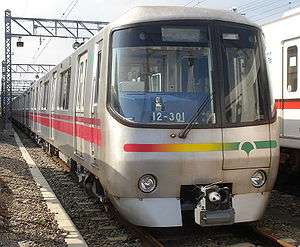 Set 30 in October 2006 | |
| In service | 1991–present |
| Manufacturer | 12-000 series: Nippon Sharyo, Hitachi (3rd and 4th batches) 12-600 series: Kawasaki Heavy Industries (1st batch), Nippon Sharyo (2nd batch) |
| Constructed | 12-000 series: 1990–2000, 12-600 series: 2012–present |
| Entered service | 12-000 series: 1991, 12-600 series: 2012 |
| Number built | 12-000 series: 424 vehicles (53 sets), 12-600 series: 80 vehicles (10 sets) |
| Number in service | 464 vehicles (58 sets) |
| Number preserved | 2 vehicles |
| Number scrapped | 40 vehicles (5 sets) |
| Formation | 8 cars per trainset |
| Capacity | 780 (328/336 seated) |
| Operator(s) | Toei |
| Depot(s) | Kiba |
| Line(s) served | E Toei Oedo Line |
| Specifications | |
| Car body construction | Aluminium |
| Car length | 16,750 mm (54.95 ft) (end cars) 16,500 mm (54.1 ft) (intermediate cars) |
| Width | 12-000 series: 2,498 mm (8.196 ft), 12-600 series: 2,490 mm (8.17 ft) |
| Height | 12-000 series: 3,145 mm (10.318 ft), 12-600 series: 3,145 mm (10.318 ft) |
| Doors | 3 pairs per side |
| Maximum speed | 70 km/h (43 mph) |
| Weight | 12-000 series: 200 t (1st-2nd batches), 197 t (3rd-4th batches), 12-600 series: 25.5–25.9 t per car |
| Traction system | Linear motor (Hitachi GTO-VVVF, IGBT-VVVF and SiC-VVVF) |
| Power output | 1,920 kW |
| Acceleration | 3.0 km/h/s |
| Deceleration | 3.5 km/h/s (4.5 km/h/s for emergency brake) |
| Electric system(s) | 1,500 V DC overhead line |
| Current collection method | Pantograph |
| Bogies | T-12D |
| Braking system(s) | Regenerative brake, Brake-by-wire |
| Safety system(s) | ATC, ATO |
| Coupling system | Shibata rotary coupler |
| Multiple working | Off-service hauling: Toei Class E5000 |
| Track gauge | 1,435 mm (4 ft 8 1⁄2 in) |
Formation
| Designation | M2c | M1 | M2 | M1 | M1 | M2 | M1 | M2c |
|---|---|---|---|---|---|---|---|---|
| Numbering | 12-xx1 | 12-xx2 | 12-xx3 | 12-xx4 | 12-xx5 | 12-xx6 | 12-xx7 | 12-xx8 |
Interior
 Interior view
Interior view Interior view, showing priority seating
Interior view, showing priority seating
12-600 series
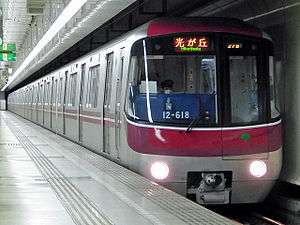
A new batch of sets, classified 12-600 series, were delivered from fiscal 2011. Broadly based on the earlier 4th-batch design (sets 16 to 53), these sets included a number of design improvements.[2] The latest batch of sets entered service on 15 February 2019 and use a different headlamp setup, with a dual headlamp-taillamp fixture; as opposed to shield-beam headlamps as used on the first eight sets, these use LED fixtures.
As of 2018, ten sets are in service and are all based at Kiba Depot.
Formation
The 12-600 sets are formed as shown below, with all cars motored.[2]
| Car No. | 1 | 2 | 3 | 4 | 5 | 6 | 7 | 8 |
|---|---|---|---|---|---|---|---|---|
| Designation | M2c | M1 | M2 | M1 | M1 | M2 | M1 | M2c |
| Numbering | 12-6x1 | 12-6x2 | 12-6x3 | 12-6x4 | 12-6x5 | 12-6x6 | 12-6x7 | 12-6x8 |
| Weight (t) | 25.5 | 25.9 | 25.8 | 25.9 | 25.9 | 25.8 | 25.9 | 25.7 |
| Capacity (total/seated) | 90/36 | 100/44 | 100/44 | 100/40 | 100/40 | 100/44 | 100/44 | 90/36 |
Interior
 Interior of a 12-600 series set
Interior of a 12-600 series set A wheelchair space at the end of a car
A wheelchair space at the end of a car Priority seating
Priority seating
Build history
The 12-600 series fleet details are as shown below.[3][4]
| Set No. | Manufacturer | Date delivered |
|---|---|---|
| 12-611 | Kawasaki Heavy Industries | 20 November 2011 |
| 12-621 | Kawasaki Heavy Industries | 9 April 2012 |
| 12-631 | Nippon Sharyo | February 2015 |
| 12-641 | Nippon Sharyo | March 2015 |
| 12-651 | Nippon Sharyo | November 2015 |
| 12-661 | Nippon Sharyo | November 2015 |
| 12-671 | Nippon Sharyo | May 2016[5] |
| 12-681 | Nippon Sharyo | June 2016[5] |
| 12-691 | Kawasaki Heavy Industries | 18 May 2018 |
| 12-701 | Kawasaki Heavy Industries |
History
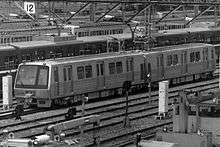
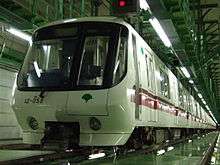
Two prototype cars, numbered 12-001 and 12-002, were delivered from Tokyu Car Corporation in April 1986. These cars had stainless steel bodies and were originally built with conventional traction motors. The cars were converted to linear motor propulsion in 1987, with testing conducted on a special test track at Magome Depot. Following successful testing, it was announced in December 1988 that linear motor propulsion would be used for the new Toei Ōedo Line (then Line 12) under construction in Tokyo.
The first production trains were delivered as six-car sets from Nippon Sharyo to Hikarigaoka Depot from September 1990 for testing on the line between Hikarigaoka and Nerima before entering revenue service in December 1991.[6]
A total of 424 vehicles were subsequently built by Nippon Sharyo and Hitachi up until 2001, formed as 53 8-car sets. The production trains featured aluminium bodies, and the first six sets were painted.[1][6]
The first 6th-batch 12-600 series set (cars 12-611 to 12-618) was delivered from the Kawasaki Heavy Industries factory in Hyōgo Prefecture in August 2011.[7] It entered service on 23 February 2012.[8] On 30 March 2015, Toei Subway announced it had ordered a second batch of 12-600 series trains. On these trains, the magenta stripe is located at the height of the windows so it can be seen above the platform edge doors installed at every station. LCD information displays are provided above the doors. The trains entered service on 6 April 2015, with six units to be delivered by June 2016, replacing older 12-000 series trains.[9][10]
The last remaining first-batch trains (sets 01 to 06) are scheduled to be withdrawn by the end of June 2016.[11]
Preserved examples
The two prototype cars, 12-001 and 12-002 are preserved at Chihaya Flower Park in Toshima, Tokyo.[12]
Gallery
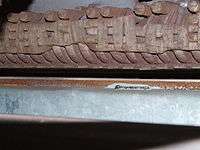 Linear motor as used on the 12-000 series
Linear motor as used on the 12-000 series T-12D bogie as used on the Toei 12-000 series. Note the low height of the bogie enabled by the use of linear motors.
T-12D bogie as used on the Toei 12-000 series. Note the low height of the bogie enabled by the use of linear motors.- A 12-000 series EMU (left) and a class E5000 electric locomotive (right). The class E5000 locomotive is used to haul 12-000 series units to Magome depot for major overhauls.
References
- 私鉄車両編成表 私鉄車両編成表 2010 [Private Railway Rolling Stock Formations - 2010]. Japan: Kotsu Shimbunsha. August 2010. p. 30. ISBN 978-4-330-15310-0.
- "東京都交通局12-600形(大江戸線)" [Toei 12-600 series (Ōedo Line)]. Tetsudō Daiya Jōhō Magazine. Vol. 41 no. 336. Japan: Kōtsū Shimbun. April 2012. p. 82.
- 私鉄車両編成表 2014 [Private Railway Rolling Stock Formations - 2014] (in Japanese). Japan: Kotsu Shimbunsha. 24 July 2014. p. 33. ISBN 978-4-330-48414-3.
- 私鉄車両編成表 2016 [Private Railway Rolling Stock Formations - 2016] (in Japanese). Japan: Kotsu Shimbunsha. 25 July 2016. p. 34. ISBN 978-4-330-70116-5.
- 私鉄車両のうごき [Private Railway Rolling Stock Changes]. Tetsudo Daiya Joho Magazine (in Japanese). Vol. 45 no. 390. Japan: Kotsu Shimbun. October 2016. p. 127.
- Kajiwara, Hisashi (July 2009). "公営地下鉄在籍両数ビッグ3 東京都交通局" [Top 3 Subway Vehicle Owners: Toei]. Japan Railfan Magazine. Vol. 49 no. 579. Japan: Kōyūsha. pp. 128–139.
- 都営大江戸線向け12-600形が甲種輸送される [Toei Oedo Line 12-600 series delivered]. Japan Railfan Magazine Online (in Japanese). Japan: Koyusha Co., Ltd. 29 August 2011. Retrieved 30 August 2011.
- 12-600形 営業運転開始 [12-600 series enters revenue service]. RM News (in Japanese). Japan: Neko Publishing. 24 February 2012. Retrieved 24 February 2012.
- 都営大江戸線、12-600形を増備…ラインカラーは車体上部に [Further 12-600 series trains ordered for Toei Oedo Line] (in Japanese). Japan: IID Inc. 31 March 2015. Retrieved 31 March 2015.
- 都営大江戸線に新車両がデビューします。 [New trains to enter service on Toei Oedo Line] (in Japanese). Japan: Toei. 30 March 2015. Retrieved 31 March 2015.
- 【東京都】12-000形1次車が6月末で引退 [Toei 12-000 series 1st-batch trains to be withdrawn at end of June]. RM News (in Japanese). Japan: Neko Publishing Co., Ltd. 27 June 2016. Archived from the original on 27 June 2016. Retrieved 27 June 2016.
- Okada, Seiichi (September 2012). "魅惑の公園保存車両 4" [Fascinating park-preserved rolling stock (Part 4)]. Japan Railfan Magazine. Vol. 52 no. 617. Japan: Kōyūsha Co., Ltd. pp. 96–97.
External links
| Wikimedia Commons has media related to Toei 12-000 series. |
| Wikimedia Commons has media related to Toei 12-600 series. |
- Nippon Sharyo 12-000 series information (in Japanese)
- Nippon Sharyo 12-600 series information (in Japanese)
